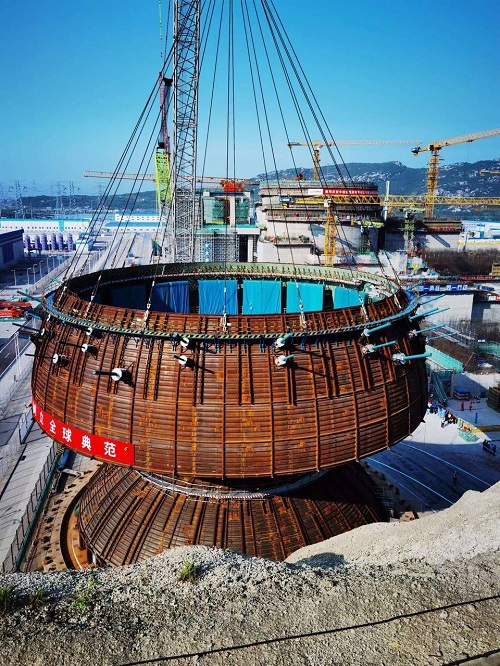
The large-sized metal structure with diameter of 44 metres and weighing 391 tonnes was installed in its design position using a crane with the maximum lifting capacity of 2,000 tonnes. The whole process took about three hours, and the accuracy of the lift requires millimetre precision
"Moving the crawler crane is like walking a tightrope. You can't even deviate a bit from the route. But thanks to our shared experiences and analysis, we succeeded. It's the result of combined efforts of thousands of us at the site," said Wen Xin, chief crawler crane operator for the mission.
The agreement for construction of Tianwan units 7&8 was signed by Russia and China in 1918 and commissioning is scheduled for 2026-2027. Tianwan NPP is owned and operated by the Jiangsu Nuclear Power Corporation, whose shareholders are CNNC (50% stake), China Power Investment Corporation (30%) and Jiangsu Guoxin Group (20%). Currently, six units are operating at Tianwan NPP: units 1-4 with Russian design VVER-1000 reactors, commissioned between 2007 to 2018, and units 5&6 with Chinese ACPR-1000s, commissioned in 2020 and 2021.Units 7&8 are VVER-1200 reactors.
“It is two years since Russian President Vladimir Putin and China’s President Xi Jinping took part via by video link in the ceremony marking the pouring for first concrete for unit 7,” said Alexey Bannik, Vice President for Projects in China and Prospective Projects for Atomstroyexport (part of Rosatom). This project is a bright example of successful cooperation between Russia and China. “Over several decades, specialists from our countries have been constructing together the most advanced NPP units, improving and optimising production processes, and moving towards technological sovereignty”, he noted.
The next stage will see installation of the top tier of the inner containment and installation of equipment and pipelines with the total weight of 214 tons. This will pave the way for installation of the reactor pressure vessel, steam generators, emergency core cooling system tanks, pressurizer, reactor coolant pumps and other components as well as welding of the main coolant pipeline.